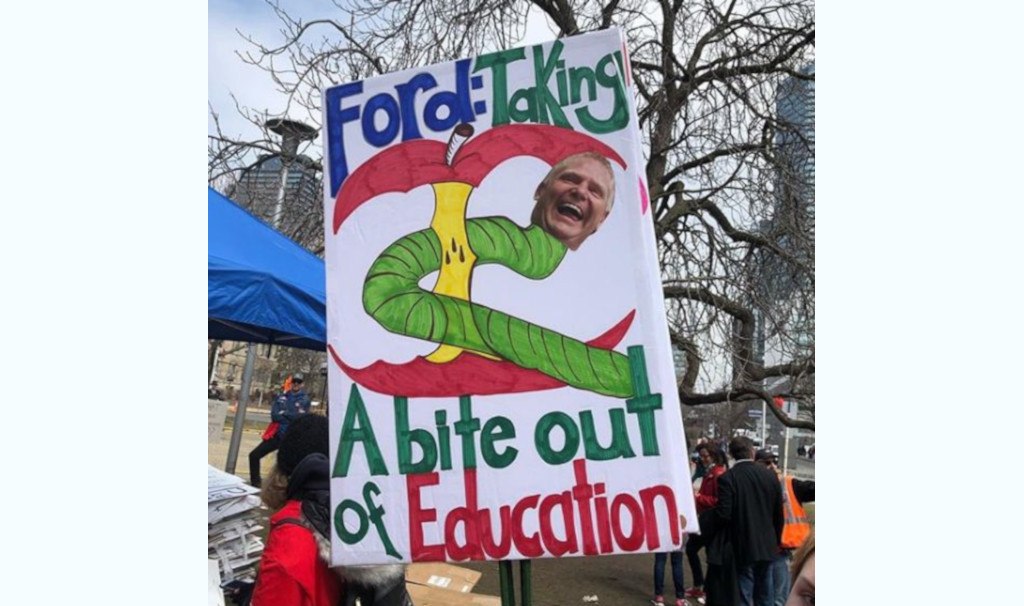On April 4, 100,000 to 200,000 school students walked out of 700 schools in protest against the Ford government’s plan to increase class size increases and other attacks on their education. The mood was energetic and enthusiastic. The students knew why they were protesting – to protect their education.
Laughingly, Ford’s petulant comment even before the protests had begun was: “This is about the union bosses telling the teachers and the students what to do… That’s what the union bosses are doing right now. It’s absolutely shameful that they’re using our students as a bunch of pawns.” Anyone who watched the various TV clips of the student protests could see that they were genuine expressions of student anger with a hardly an adult in sight. So, in Doug Ford’s world, teachers are unable to get students to put their cell phones away but they are able to politicize and manipulate them to walk out in an anti-government protest!
Two days later, it was the turn of the teachers unions, taking up the same issues as the students. Between 25,000 and 30,000 showed up in Toronto for a province-wide protest. The union organized buses to bring teachers, education workers, their families and supporters from as far afield as Thunder Bay and Sudbury to the provincial legislature.
Since the start of the Ford government, education has been a prime focus for attack. It started with the issue of the sex education curriculum. It continued with a cancellation of school repairs that were funded by the revenues collected through the cap-and-trade program (another Ford cancellation!) of the previous government. Then came an announcement removing post-secondary grants for low-income students and reversing recent improvements to the Ontario Student Assistance Plan. This was accompanied by a reduction in post-secondary operating funding through unfunded tuition reductions. Another attack in the post-secondary sector was the “Student Choice Initiative,” which will allow students to opt out of student union fees outside of “essential campus health and safety initiatives.” The next attack was on funding to children’s autism services through a voucher-based approach.

Fewer teachers means fewer course offerings. It won’t take long for students to discover that many of the courses, particularly the optional ones, they signed up for are gone. The impact will be greater where students in smaller schools will have a harder time getting all the courses they need to graduate.
The latest in this barrage came in March with a package of announcements including a ban on students using cell phones in school and making it mandatory for High School students to take a minimum of four online courses as part of the 30 credits to complete the High School Diploma. The most blatant, impacting both students and teachers, was the announcement increasing class size averages in Grades 4 through 12. This would have an effect on both students and teachers, as classes could have 35 to 40 students. From the cost cutting point of view, which is what Ford is mainly interested in, the result would be a reduction of around 10,000 teaching jobs over the next four years. Ford (“nobody will be laid off”) claims these job losses will happen through “attrition” — retirements, resignations, etc. Yet Ford has also imposed a hiring freeze on Boards, meaning that graduates coming out of the Faculties of Education are going to be completely out of luck in finding employment.
But there is another objective to the class size proposal. Let’s call it “tough love.” According to Lisa Thompson, Education Minister, the increase in class size is aimed at boosting student “resilience” so that they will be prepared for “the real world.” “When students are currently preparing to go off to post-secondary education, we’re hearing from professors and employers alike that they’re lacking coping skills and they’re lacking resiliency.”
Up to now the resistance has had a slow build-up. On the issue of autism funding, there was lobbying and protests from parents which pushed Ford to go back on his original plans by tweaking the funding. On sex education, the Tories were forced to backtrack and keep much of the 2015 curriculum in place. This came through a combination of a court judgment, initiated by the elementary teachers’ union, and walkouts by high school students.
Resistance from the unions has also been slow to build. However, Spring seems to be seeing an awakening for labour. At the end of March, the Ontario Federation of Labour organized a 800 strong conference “Power of Many — Take Back Ontario.” The purpose was to promote the organizing of “Rapid Response Networks,” i.e. local organizing committees and rapid response teams of labour and community activists that deliver prompt solidarity actions in response to cuts and privatization efforts by the Ford government. This could mark the start of a coordinated fightback involving students, workers and local communities. It will need to be developed further to achieve something similar to (and going beyond) the regional one-day strikes that took place in Ontario in the 1990s against the Conservative Mike Harris government. Saturday rallies and after work protests can be useful to build support but it’s going to take strike action to get the attention of Ford and his business backers. Labour has still hardly flexed its muscles. Yet Ford is steadily losing popularity and he can be taken down.


